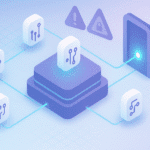According to McKinsey’s 2023 “State of AI” report, 55% of organizations now use AI in at least one business function, marking a dramatic shift in how work gets done. This rapid adoption isn’t slowing – Deloitte’s “Tech Trends 2024” survey reveals that 79% of organizations report having multiple AI initiatives moving from pilot to production, with generative AI leading the charge. Yet amid this surge in AI adoption, many organizations have responded with what seems like a straightforward solution: completely blocking access to generative AI services. This “Block All” strategy appears attractive at first glance – it promises to buy the organization some time to sort out their Gen AI policy while hopefully protecting intellectual property, ensuring data privacy, maintaining regulatory compliance, and shielding organizations from AI-related risks.
The impulse is understandable. With headlines about AI-driven privacy breaches, concerns about sensitive data being used to train AI models, and uncertainty around regulatory requirements, many security and compliance teams see a complete ban as a temporary yet safe path forward. For regulated industries like healthcare and finance, where data protection isn’t just good practice but a legal requirement, the temptation to postpone this problem by simply shutting the door on AI is particularly strong.
However, this apparently simple solution creates more problems than it solves. Not only is a “Block All” strategy increasingly difficult to implement technically, but it also drives AI use underground, creates security blind spots, and puts organizations at a significant competitive disadvantage. This same approach gave birth to ShadowAI during the time of cloud app adoption. In an era where AI capabilities are being embedded into everyday business tools – from email clients to productivity suites – attempting to block all AI usage is becoming impossible. The real question isn’t whether your employees will use AI tools, but how to ensure they do so safely and productively.
The Reality of Modern Work
The rise of shadow IT isn’t new to corporate security teams. According to Gartner, by 2027, 75% of employees will acquire, modify, or create technology outside IT’s visibility – up from 41% in 2022. But the proliferation of AI tools has dramatically accelerated this trend. A recent Salesforce survey found three out of five employees are already using AI tools at work, whether officially sanctioned or not. When faced with restrictions, employees simply find ways around them – using proxies, mobile hotspots, or web-based versions of blocked applications.
This circumvention becomes unavoidable as AI features are now woven into everyday business tools. Microsoft’s Copilot across Office, Google’s AI in Workspace, and Zoom’s AI-powered features mean blocking generative AI often requires disabling critical productivity tools entirely. The integration extends to Grammarly, Adobe’s Creative Suite, Salesforce’s Einstein AI, and project management platforms – these aren’t separate tools but core features of essential business software.
Companies like Samsung, Apple, and JPMorgan Chase have already discovered the “Block All” approach is unsustainable, with initial bans being replaced by usage guidelines and controlled access policies. The lesson is clear: trying to completely block AI access is like trying to prevent employees from using the internet in the 1990s – it’s impractical and detrimental to business operations. Organizations must shift from prohibition to protection, from blocking to enabling secure usage.
The Technical Impossibility of “Block All”
When companies implement a “Block All” strategy for generative AI, they typically start by blocking obvious services like ChatGPT or Github Copilot. Acuvity’s own agentic-powered research, however, reveals that nearly 20 new generative AI services debut each week. But blocking access to standalone generative AI services is just the tip of the iceberg.
The real challenge lies in how generative AI capabilities are being rapidly embedded into everyday business tools. Microsoft’s Copilot integration means generative AI now powers features across the entire Office suite – from generating email drafts in Outlook to creating PowerPoint presentations from simple prompts. These aren’t optional add-ons that can be easily disabled; they’re becoming core to how these tools function. GitHub Copilot, which provides generative AI-powered code suggestions, is now so deeply integrated into development workflows that blocking it can reduce developer productivity by up to 55% according to GitHub’s internal studies.
The proliferation of generative AI APIs makes complete blocking technically impossible. Consider services like OpenAI’s GPT-4 API or Anthropic’s Claude API – they can be accessed through countless third-party applications, browser extensions, and mobile apps. Even if a company blocks access to known generative AI endpoints, new ones emerge daily. Popular business tools like Jasper, Copy.ai, and Synthesia offer their own generative AI capabilities, and the list continues to grow..
A Better Approach
Rather than attempting to block all generative AI access, forward-thinking organizations are adopting visibility-first strategies that acknowledge the inevitability of AI adoption while maintaining security and control. This approach starts with understanding – monitoring and analyzing how employees are actually using generative AI tools, what business problems they’re solving, and where potential risks might arise.
By implementing AI visibility solutions, organizations gain crucial insights into usage patterns, enabling targeted, intelligent controls based on actual behavior. Once organizations understand how generative AI is being used, they can implement selective blocking or content redaction where truly necessary – for example, automatically redacting sensitive and proprietary data rather than blocking AI access entirely. This represents a natural maturation of AI governance that’s only possible through comprehensive monitoring.
The key components of a successful AI governance program include:
- Clear usage policies and employee training on safe AI practices
- Technical controls that monitor usage, selectively block or redact risky content where necessary, and alert on policy violations
- Integration with existing security frameworks and deployment of controls based on observed risks
Leading organizations demonstrate the success of this approach. Morgan Stanley developed a custom AI assistant with strict data security protocols, while Accenture implemented an AI governance program enabling 700,000 employees to use AI tools productively while protecting client information.
The results of these visibility-first programs include increased productivity, better security as AI usage moves from shadow IT to monitored channels, and enhanced innovation as teams experiment within defined guardrails.
The path forward isn’t about blocking AI, but embracing it safely. By implementing comprehensive visibility and governance programs, organizations can harness the power of generative AI while maintaining control over their data and operations.
The Bottom Line
The “Block All” approach to generative AI might seem like the safest option, but as we’ve seen, it’s becoming both ineffective and technically impossible to maintain. Employee workarounds, integrated AI features in essential business tools, and the rapid proliferation of AI services all undermine blocking strategies.
Forward-thinking organizations are instead embracing visibility-first approaches that acknowledge AI’s inevitability while maintaining security. By monitoring usage patterns and implementing targeted controls only where necessary, companies can harness AI’s competitive advantages while managing risks.
Now is the time to reassess your AI governance strategy. The most successful companies won’t be those that avoided AI, but those that developed frameworks for embracing it safely. The question isn’t whether your employees will use generative AI – it’s whether they’ll do so with your guidance or despite your restrictions.





